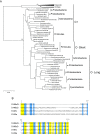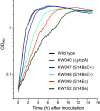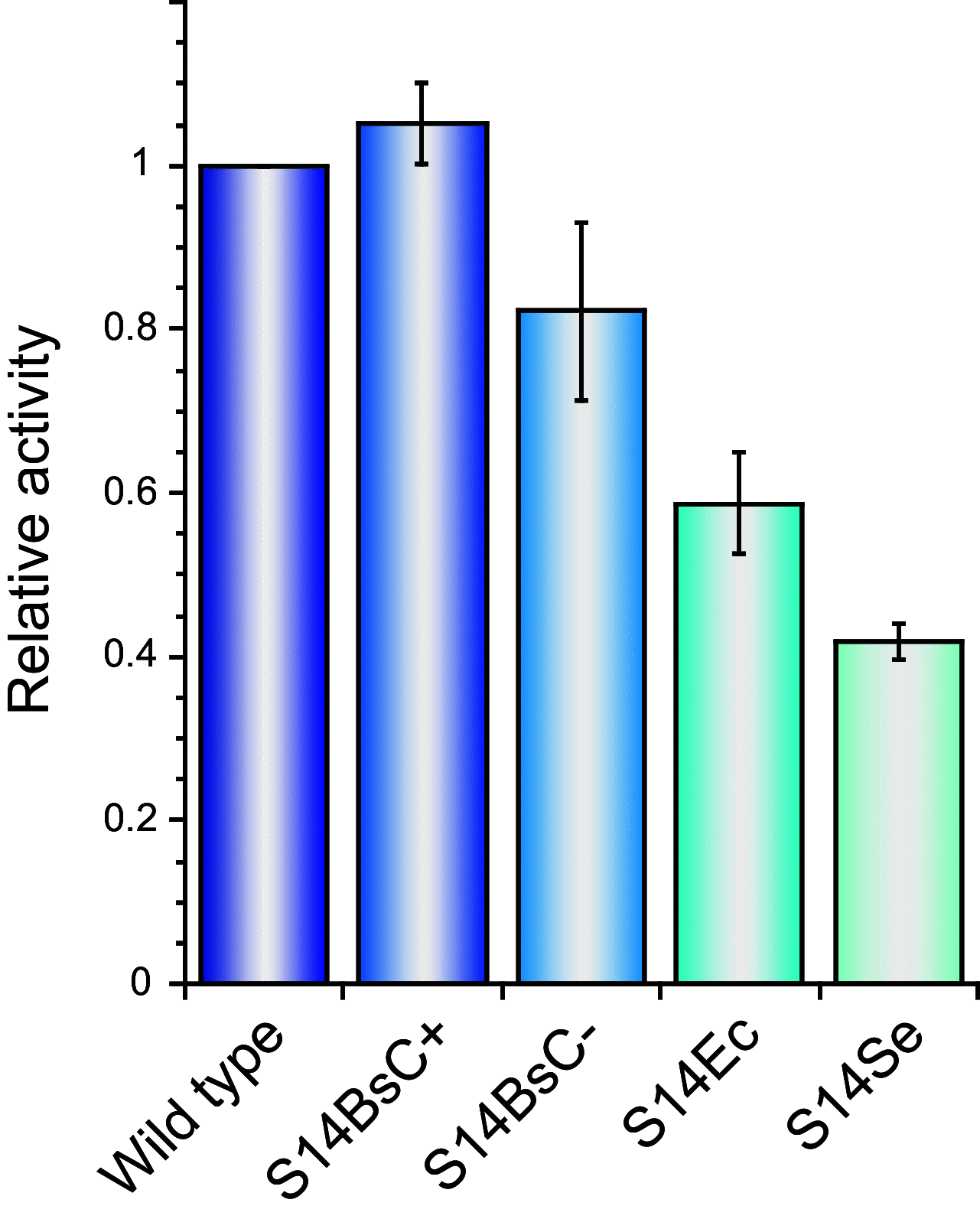Evolution of Ribosomal Protein S14 Demonstrated by the Reconstruction of Chimeric Ribosomes in Bacillus subtilis
- PMID: 33649148
- PMCID: PMC8088600
- DOI: 10.1128/JB.00599-20
Evolution of Ribosomal Protein S14 Demonstrated by the Reconstruction of Chimeric Ribosomes in Bacillus subtilis
Abstract
Ribosomal protein S14 can be classified into three types. The first, the C+ type has a Zn2+ binding motif and is ancestral. The second and third are the C- short and C- long types, neither of which contain a Zn2+ binding motif and which are ca. 90 residues and 100 residues in length, respectively. In the present study, the C+ type S14 from Bacillus subtilis ribosomes (S14BsC+) were completely replaced by the heterologous C- long type of S14 from Escherichia coli (S14Ec) or Synechococcus elongatus (S14Se). Surprisingly, S14Ec and S14Se were incorporated fully into 70S ribosomes in B. subtilis However, the growth rates as well as the sporulation efficiency of the mutants harboring heterologous S14 were significantly decreased. In these mutants, the polysome fraction was decreased and the 30S and 50S subunits accumulated unusually, indicating that cellular translational activity of these mutants was decreased. In vitro analysis showed a reduction in the translational activity of the 70S ribosome fraction purified from these mutants. The abundance of ribosomal proteins S2 and S3 in the 30S fraction in these mutants was reduced while that of S14 was not significantly decreased. It seems likely that binding of heterologous S14 changes the structure of the 30S subunit, which causes a decrease in the assembly efficiency of S2 and S3, which are located near the binding site of S14. Moreover, we found that S3 from S. elongatus cannot function in B. subtilis unless S14Se is present.IMPORTANCE S14, an essential ribosomal protein, may have evolved to adapt bacteria to zinc-limited environments by replacement of a zinc-binding motif with a zinc-independent sequence. It was expected that the bacterial ribosome would be tolerant to replacement of S14 because of the previous prediction that the spread of C- type S14 involved horizontal gene transfer. In this study, we completely replaced the C+ type of S14 in B. subtilis ribosome with the heterologous C- long type of S14 and characterized the resulting chimeric ribosomes. Our results suggest that the B. subtilis ribosome is permissive for the replacement of S14, but coevolution of S3 might be required to utilize the C- long type of S14 more effectively.
Keywords: Bacillus subtilis; ribosomal protein S14; ribosome; zinc.
Copyright © 2021 American Society for Microbiology.
Figures








Similar articles
-
Towards an elucidation of the roles of the ribosome during different growth phases in Bacillus subtilis.Biosci Biotechnol Biochem. 2010;74(3):451-61. doi: 10.1271/bbb.90859. Epub 2010 Mar 7. Biosci Biotechnol Biochem. 2010. PMID: 20208344 Review.
-
The contribution of the zinc-finger motif to the function of Thermus thermophilus ribosomal protein S14.J Mol Biol. 2007 Jun 1;369(2):489-97. doi: 10.1016/j.jmb.2007.03.056. Epub 2007 Mar 24. J Mol Biol. 2007. PMID: 17442343
-
Translation in Bacillus subtilis is spatially and temporally coordinated during sporulation.Nat Commun. 2024 Aug 21;15(1):7188. doi: 10.1038/s41467-024-51654-6. Nat Commun. 2024. PMID: 39169056 Free PMC article.
-
A fail-safe system for the ribosome under zinc-limiting conditions in Bacillus subtilis.Mol Microbiol. 2007 Jan;63(1):294-307. doi: 10.1111/j.1365-2958.2006.05513.x. Epub 2006 Dec 5. Mol Microbiol. 2007. PMID: 17163968
-
Proteomic study of the Bacillus subtilis ribosome: Finding of zinc-dependent replacement for ribosomal protein L31 paralogues.J Gen Appl Microbiol. 2006 Oct;52(5):249-58. doi: 10.2323/jgam.52.249. J Gen Appl Microbiol. 2006. PMID: 17310068 Review.
Cited by
-
A model industrial workhorse: Bacillus subtilis strain 168 and its genome after a quarter of a century.Microb Biotechnol. 2023 Jun;16(6):1203-1231. doi: 10.1111/1751-7915.14257. Epub 2023 Apr 1. Microb Biotechnol. 2023. PMID: 37002859 Free PMC article. Review.
-
Analysis of genetic requirements and nutrient availability for Staphylococcus aureus growth in cystic fibrosis sputum.mBio. 2025 May 14;16(5):e0037425. doi: 10.1128/mbio.00374-25. Epub 2025 Apr 2. mBio. 2025. PMID: 40172197 Free PMC article.
-
Sarecycline inhibits protein translation in Cutibacterium acnes 70S ribosome using a two-site mechanism.Nucleic Acids Res. 2023 Apr 11;51(6):2915-2930. doi: 10.1093/nar/gkad103. Nucleic Acids Res. 2023. PMID: 36864821 Free PMC article.
-
Analysis of genetic requirements and nutrient availability for Staphylococcus aureus growth in cystic fibrosis sputum.bioRxiv [Preprint]. 2024 Sep 25:2024.09.24.614743. doi: 10.1101/2024.09.24.614743. bioRxiv. 2024. Update in: mBio. 2025 May 14;16(5):e0037425. doi: 10.1128/mbio.00374-25. PMID: 39386554 Free PMC article. Updated. Preprint.
-
Ribosomes lacking bS21 gain function to regulate protein synthesis in Flavobacterium johnsoniae.Nucleic Acids Res. 2023 Feb 28;51(4):1927-1942. doi: 10.1093/nar/gkad047. Nucleic Acids Res. 2023. PMID: 36727479 Free PMC article.
References
Publication types
MeSH terms
Substances
Supplementary concepts
LinkOut - more resources
Full Text Sources
Other Literature Sources
Molecular Biology Databases

